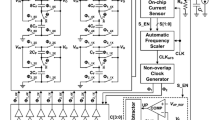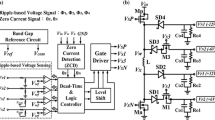Abstract
In this paper, an integrated multiple-output switched-capacitor (SC) converter with time-interleaved control and output current regulation is presented. The SC converter can reduce the number of passive components and die areas by using only one flying capacitor and by sharing active devices. The proposed converter has three outputs for individual brightness control of red–green–blue (RGB) LEDs. Each output directly regulates the current due to the V–I characteristics of LEDs, which are sensitive to PVT variations. In the proposed converter, the current-sensing technique is used to control the output current, instead of current-regulation elements (resistors or linear regulators). Additionally, in order to reduce the active area, three outputs share one current-sensing circuit. In order to improve the sensing accuracy, bias current compensation is applied to a current-sensing circuit. The proposed converter has been fabricated with a CMOS 0.13-μm 1P6M CMOS process. The input voltage range of the converter is 2.5–3.3 V, and the switching frequency is 200 kHz. The peak power efficiency reaches 71.8 % at V IN =2.5 V, I LED1 = 10 mA, I LED2 = 18 mA, and I LED3 = 20 mA. The current variations of individual outputs at different supply voltages are less than 0.89, 0.72, and 0.63 %, respectively.












Similar content being viewed by others
References
Yu, W., Lai, J.-S., Ma, H., & Zheng, C. (2011). High-efficiency dc–dc converter with twin bus for dimmable LED lighting. IEEE Transactions on Power Electronics, 26(8), 2095–2100.
Rao, S., Khan, Q., Bang, S., Swank, D., Rao, A., McIntyre, W., & Hanumolu, P. K. (2011). A 1.2-A buck-boost LED driver with on-chip error averaged senseFET-based current sensing technique. IEEE Journal of Solid-State Circuits, 46(12), 1–12.
Qu, X., Wong, S. C., & Tse, C. K. (2007). Color control system for RGB LED light sources using junction temperature measurement. Industrial Electronics Society Conference.
Lo, Y.-K., Wu, K.-H., Pai, K.-J., & Chiu, H.-J. (2009). Design and implementation of RGB LED drivers for LCD backlight modules. IEEE Transactions on Industrial Electronics, 56(12), 4862–4871.
Hu, Y., & Jovanović, M. M. (2008). LED driver with self-adaptive drive voltage. IEEE Transactions on Power Electronics, 23(6), 3116–3125.
AAT3128 Datasheet. (2008). Advanced Analogic Technologies, Inc., Scott Boulevard, Santa Clara, CA.
MAXIM Application Note AN3256. http://www.maxim-ic.com/an3256.
Khatib, M. (2009). Ballast resistor calculation: current matching in parallel LEDs, Texas Instrument Application Report SLVA325.
LTC3212 Datasheet. (2007). Linear Tech. Corp., McCarthy Blvd., Milpitas, CA.
MAX1574 Datasheet. (2003). Maxim Integr. Products, Inc., Sunnyvale, CA
NCP5602 Datasheet. (2008). On Semicond. Components Indus., LLC.
Zhang, J., Xu, L., Wu, X., & Qian, Z. (2011). A precise passive current balancing method for multioutput LED drivers. IEEE Transactions on Power Electronics, 26(8), 2149–2159.
Chen, H., Zhang, Y., & Ma, D. (2012). A SIMO parallel-string driver IC for dimmable LED backlighting with local bus voltage optimization and single time-shared regulation loop. IEEE Transactions on Power Electronics, 27(1), 452–462.
Wang, S., Cho, G. & Cho, G. (2012). A high-stability emulated absolute current hysteretic control single-inductor 5-output switching DC-DC converter with energy sharing and balancing. IEEE International Solid-State Circuits Conference on Digital Technology, 276–278.
Huang, M. H., Fan, P.-C. & Chen, K.-H. (2009). Low-ripple and dual-phase charge pump circuit regulated by switched-capacitor-based bandgap reference. IEEE Transactions on Power Electronics, 24(5), 1161–1172.
Singh, R. P., & Je, M. (2011). Multiple output switched capacitor DC–DC converter for low power applications. IEEE Proceedings on International Symposium on Integrated Circuits, 148–151.
Henry, G. C. (2003). Multiple output charge pump. U.S. Patent 6636104 B2.
Lee, C. F., & Mok, P. K. T. (2004). A monolithic current-mode CMOS dc–dc converter with on-chip current-sensing technique. IEEE Journal of Solid-State Circuits, 39(1), 3–14.
Chae, C., Le, H., Lee, K., Cho, G., & Cho, G. (2009). A single-inductor step-up DC–DC switching converter with bipolar outputs for active matrix OLED mobile display panels. IEEE Journal of Solid-State Circuits, 44(2), 509–524.
Acknowledgments
This research was supported in part by the Ministry of Knowledge Economy, Korea, under the University ITRC support program supervised by the National IT Industry Promotion Agency (NIPA-2013-H0301-13-1007), and supported in part by Basic Science Research Program through the National Research Foundation of Korea (NRF) funded by the Ministry of Education (2013R1A1A2011973).
Author information
Authors and Affiliations
Corresponding author
Rights and permissions
About this article
Cite this article
Ahn, Y., Jeon, I. & Roh, J. A multiple-output switched-capacitor DC–DC converter for individual brightness control of RGB LEDs with time-interleaved control and output current regulation. Analog Integr Circ Sig Process 79, 345–354 (2014). https://doi.org/10.1007/s10470-014-0269-1
Received:
Accepted:
Published:
Issue Date:
DOI: https://doi.org/10.1007/s10470-014-0269-1




